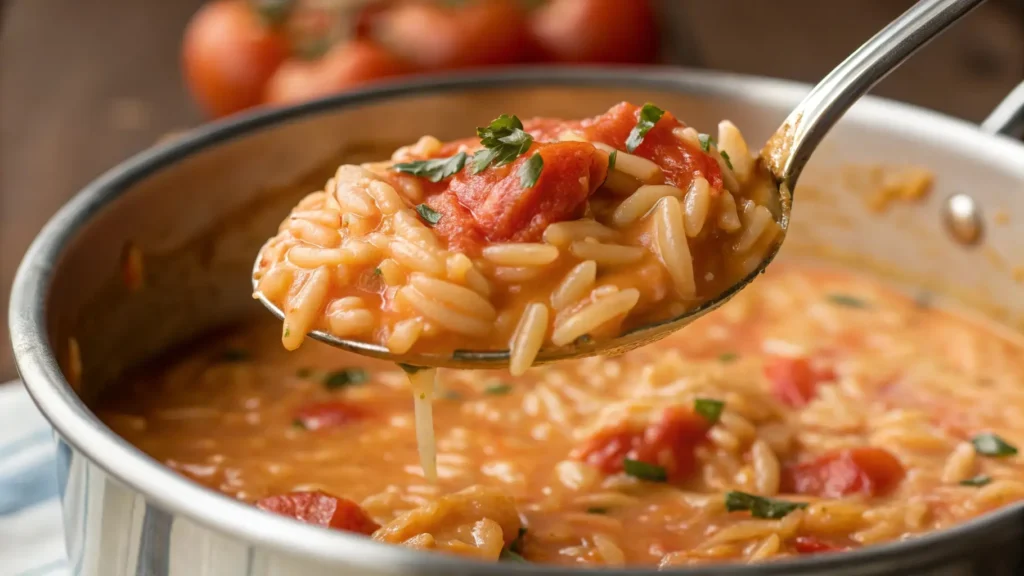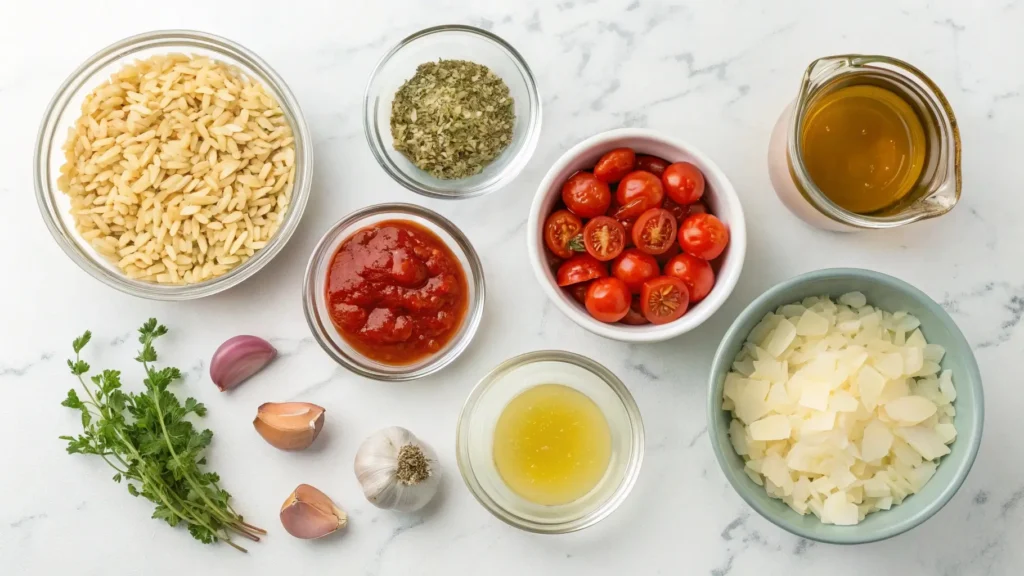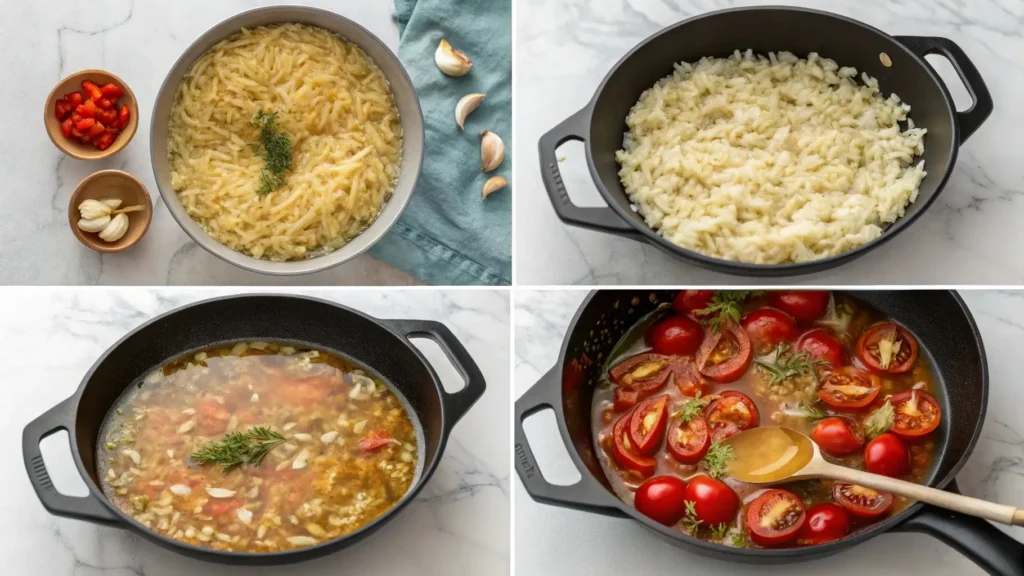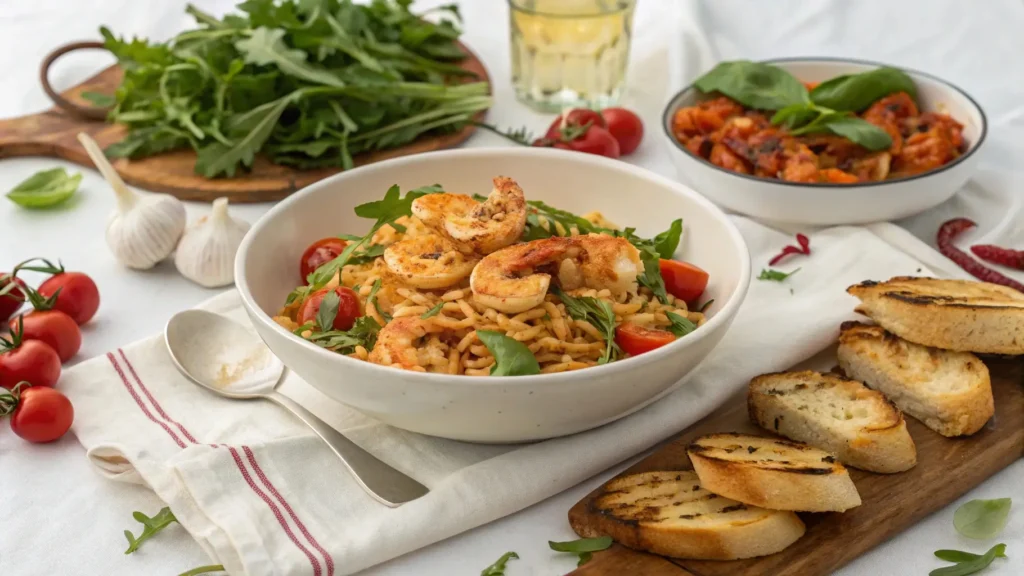Creamy Tomato Orzo Recipe – One Pot, 25 Minutes, So Much Flavor
Imagine this: You walk into the kitchen after a long day — tired, hungry, and in no mood for a pile of dirty dishes. You open your pantry, hoping something (anything!) will jump out as tonight’s easy fix. That’s when you remember this: a one-pot, creamy tomato orzo that tastes like it simmered all day… but took you 25 minutes, tops.
This isn’t just another pasta dish. It’s a silky, tomato-infused comfort hug in a bowl. The orzo — that charming pasta shape pretending to be rice — soaks up the smoky tang of fire-roasted tomatoes and turns irresistibly creamy, without a drop of heavy cream.
Whether you’re cooking for one, feeding picky eaters, or trying to impress someone with minimal effort, this recipe hits the mark. Plus, it adapts like a dream — vegan, gluten-free, or protein-packed. Your call.
By the end of this guide, you’ll know exactly how to make it (with visual steps!), what to serve it with, how to avoid soggy orzo, and why this dish might just become your midweek obsession.
Table of Contents
Recipe Details
- Prep Time: 10 minutes
- Cook Time: 15 minutes
- Total Time: 25 minutes
- Servings: 4
- Calories: ~320 kcal per serving
Why This One-Pot Tomato Orzo Works

Why This Tomato Orzo Is the Perfect Easy One-Pot Dinner
When you need something quick, comforting, and cleanup-friendly, this creamy tomato orzo ticks every box. It’s exactly what most people mean when they search for an easy one-pot dinner — minimal steps, simple ingredients, and maximum satisfaction.
Here’s why it works (and wins):
- One-Pot Wonder: Everything cooks in the same pot — less mess, more flavor.
- Creamy Without Cream: Thanks to the orzo’s natural starch, the sauce thickens beautifully on its own.
- Fast Enough for Weeknights: Pantry staples to plated meal in under 30 minutes.
- Customizable: Vegan, gluten-free, high-protein? This dish adapts.
- Fire-Roasted Depth: Tomatoes that bring a slow-roasted flavor shortcut.
What makes one-pot orzo better than regular pasta?
Because orzo’s small size allows it to cook with the sauce instead of being cooked and drained separately. That means every grain absorbs the surrounding flavors like a sponge — you don’t miss a drop.
Ingredients with Purpose Tomato Orzo

This isn’t just a list — it’s the blueprint for flavor. Each ingredient below plays a key role in making your tomato orzo creamy, comforting, and deeply satisfying.
The Essentials (with the Why):
- 1 cup orzo: The pasta that pretends to be rice. Its small size means it cooks fast and absorbs flavor even faster — no draining needed.
- 1 tablespoon olive oil + 1 tablespoon butter: Olive oil adds a rich, fruity base, while a little butter finishes the dish with a subtle gloss. Vegan? Use 2 tablespoons of olive oil instead.
- 1 small yellow onion, finely chopped: Adds a gentle sweetness and aromatic base. You’ll sauté this until soft for that flavor-layering magic.
- 3 cloves garlic, minced: For warmth and a savory backbone — don’t skip it.
- 1 tablespoon tomato paste: Intensifies the tomato flavor and gives body to the sauce. It’s your secret weapon for umami.
- 1 can (14.5 oz) fire-roasted diced tomatoes: Go fire-roasted — the hint of smokiness adds a layer most tomato orzo recipes miss.
- 2 ½ cups vegetable broth (preferably low sodium): The liquid gold that cooks the orzo and forms the sauce. Don’t swap this for water unless you absolutely must — it’s what makes the flavor sing.
- Salt and freshly ground black pepper, to taste: Season as you go. A pinch early, another at the end — always taste.
- Optional: ¼ cup grated Parmesan (or vegan alternative): Adds a creamy, salty finish. A touch of luxury with zero effort.
- Optional garnish: Fresh basil or parsley, chopped: Just before serving, a sprinkle of herbs brings everything to life with color and freshness.
Do I need to pre-cook the orzo?
Nope. That’s the beauty of this dish — the orzo cooks in the sauce, soaking up all the tomato and broth as it goes. One pot. Zero fuss.
Step-by-Step Instructions Tomato Orzo
This is your smooth, no-fuss path to creamy orzo greatness. Grab one pot, follow the steps below, and in about 25 minutes, dinner is on the table — warm, comforting, and shockingly flavorful.

Step 1: Sauté the Aromatics
Heat 1 tablespoon olive oil and 1 tablespoon butter in a large skillet or saucepan over medium heat.
Add 1 small chopped onion and cook for 4–5 minutes, stirring occasionally, until translucent and soft.
Stir in 3 cloves minced garlic and cook for another 30 seconds, just until fragrant — don’t let it brown.
Step 2: Boost the Tomato Base
Add 1 tablespoon tomato paste to the pan and stir it into the onions and garlic.
Cook for 1–2 minutes, letting the paste darken slightly — this caramelization brings serious depth.
Step 3: Add the Orzo
Pour in 1 cup of orzo, stirring to coat it in the oil and tomato mixture.
Let it toast for 1–2 minutes, just like you would with risotto. This step locks in a bit of nutty flavor.
Step 4: Simmer to Creamy
Add 1 can (14.5 oz) fire-roasted diced tomatoes (with juices) and 2 ½ cups vegetable broth. Stir to combine.
Bring to a boil, then reduce the heat to medium-low. Simmer uncovered for 10–12 minutes, stirring occasionally, until the orzo is al dente and the sauce is thick and creamy.
Note: If it thickens too quickly, add a splash of broth or water.
Step 5: Finish & Serve
Taste and season with salt and pepper as needed.
If using, stir in ¼ cup grated Parmesan (or vegan equivalent) just before serving.
Top with chopped fresh basil or parsley for a pop of freshness.
How do I know when it’s done?
The orzo should be tender but not mushy, and the sauce should coat a spoon. If it’s too loose, simmer another minute. Too thick? A splash of broth will fix it instantly.
Nutrition Information (Per Serving)
- Calories: 320 kcal
- Total Fat: 9g
- Saturated Fat: 2g
- Carbohydrates: 48g
- Fiber: 4g
- Sugar: 5g
- Protein: 8g
- Sodium: 580mg
- Cholesterol: 5mg (0mg if vegan)
Note: Nutritional values vary based on exact ingredients used and optional additions like cheese or protein.
What is Orzo, Anyway?
Let’s clear something up — orzo might look like rice, but it’s pasta through and through. In fact, its name comes from the Italian word for “barley,” because of its shape, not its ingredients.
Orzo is made from semolina flour (a type of durum wheat), just like most classic Italian pasta. But its rice-like size gives it a unique edge in the kitchen: it cooks quickly, absorbs flavor like a champ, and blends seamlessly into soups, salads, or — our favorite — creamy, saucy one-pot dishes.
EatingWell: Details on orzo made from semolina, protein and carbohydrate content, and its place in a healthy diet
Pasta or rice? (And why that matters)
Here’s where things get interesting: while rice releases starch slowly and often needs rinsing, orzo gets creamy the more it simmers. That’s why it’s the perfect candidate for this recipe — it helps create a rich sauce without needing to add thickeners or dairy. And because it’s pasta, not grain, you get that satisfyingly tender chew instead of the fluff of rice.
Can I use other pasta instead of orzo?
Technically? Yes. Realistically? Not quite the same. Small pasta shapes like ditalini or pastina might work, but you’ll lose the silky consistency that makes this dish shine. Stick with orzo if you want that magical risotto-meets-pasta texture.
Tips & Tricks to Perfect It
Anyone can follow a recipe, but nailing creamy tomato orzo every time? That’s where these tips come in. Whether you’re cooking it for the first time or it’s already a regular in your weeknight rotation, these tweaks can make a noticeable difference.
How to Get the Creamiest Tomato Orzo (The Secret)
- Don’t walk away: Stirring every few minutes helps release the starch and keeps the orzo from sticking to the bottom. It’s what creates that luscious, risotto-like texture.
- Simmer gently, not aggressively: Too much heat can cook off the liquid before the orzo is ready — leaving you with crunchy bits and a dry pot.
- Finish with a swirl of richness: Even a teaspoon of butter or a sprinkle of cheese at the end adds instant silkiness. Vegan? A spoon of olive oil or vegan butter works just as well.
Making it Vegan & Dairy-Free
- Swap the butter for more olive oil or a plant-based butter.
- Ditch the cheese or use a vegan Parmesan alternative or nutritional yeast for that umami bite.
- Double down on herbs — they add brightness and balance the richness.
Gluten-Free Swaps
- Use gluten-free orzo (many health food stores carry it, often rice- or corn-based).
- Check your broth ingredients to make sure it’s certified gluten-free — some brands sneak in hidden thickeners.
Protein Boost: What to Add
If you want to turn this into a full one-bowl meal, try these mix-ins:
- Shredded rotisserie chicken – fold in at the end for instant flavor and protein.
- Chickpeas – added with the broth, they absorb the tomato sauce and stay creamy.
- Shrimp – stir in raw, peeled shrimp during the last 5 minutes of simmering. They’ll cook quickly and soak up flavor.
Can I overcook orzo?
Yes — and it happens fast. Once it’s tender with a bit of bite, pull it off the heat. If it sits too long, it’ll keep softening and get mushy. Timing is everything here.
What to Serve with Tomato Orzo

Tomato orzo is creamy, cozy, and packed with savory depth — but it shines even brighter when paired with the right sides. Think contrast: crisp, fresh, crunchy, zesty. These side dishes and accompaniments create the perfect balance, whether you’re going casual or plating up for guests.
Light & Fresh Sides
- Arugula Salad with Lemon Vinaigrette: Peppery greens cut through the richness beautifully. Add shaved fennel or radish for extra crunch.
- Cucumber Yogurt Salad: A cool, creamy contrast that echoes Mediterranean vibes — especially refreshing on warmer days. vegan tomato pasta
- Cherry Tomato & Olive Tapenade: Doubles down on the tomato element but adds a briny, punchy layer.
Protein Pairings (for a Heartier Meal)
- Grilled Chicken or Shrimp: Simple seasoning, high heat, done. These lean proteins complement the creamy orzo without competing.
- Crispy Tofu or Tempeh: Tossed in olive oil and pan-seared — perfect for a vegan-friendly protein boost.
- Roasted Chickpeas: Seasoned with smoked paprika or cumin, they add texture and nutrition.
Bread — Because You’ll Want to Swipe the Bowl
- Toasted Garlic Bread: Crunchy, buttery, and made to soak up that tomato sauce.
- Pita Wedges: Especially good if you’re leaning Mediterranean with your sides.
- Crusty Sourdough: For the rustic comfort vibes.
What if I want to serve it as a side dish?
Tomato orzo plays just as well next to something as it does as the main event. Serve it alongside:
quick Mediterranean recipe:
Recipe Categories
- Course: Main Course / Side Dish
- Cuisine: Mediterranean / Italian-Inspired
- Diet: Vegetarian (Vegan-friendly option available)
- Method: One-Pot, Stovetop
- Skill Level: Easy (Beginner-friendly)
Storing and Reheating Tomato Orzo Professionally
Tomato orzo is one of those dishes that gets even better the next day — if you reheat it right. The starch from the orzo thickens the sauce as it sits, which is great for flavor but tricky for texture. Here’s how to keep it creamy and delicious on day two (or three).
Storage Tips
- Cool before storing: Let the orzo cool to room temperature before sealing it up — this prevents condensation (aka sogginess).
- Use an airtight container: Lock in freshness and keep fridge odors out. Glass or BPA-free plastic both work.
- Shelf life: It will stay fresh in the fridge for up to 3 days. After that, the orzo starts to break down.
Reheating Without Ruining It
- Stovetop Method (Best):
- Scoop desired amount into a small saucepan.
- Add 1–2 tablespoons of broth or water per serving.
- Reheat on medium-low, stirring gently until warm and creamy again.
- Microwave Method (Faster):
- Place in a microwave-safe bowl.
- Splash in a bit of liquid (broth or water).
- Cover loosely and heat in 30-second bursts, stirring in between.
Optional: Add a fresh sprinkle of herbs or a touch of olive oil before serving to revive that just-made feeling.
Can I freeze it?
Technically, yes — but not ideal. The orzo will lose its texture and go soft. If you do freeze it, use a freezer-safe container and reheat gently with added liquid to restore some creaminess. It’s best enjoyed fresh or within a few refrigerated days.
Final Thoughts: Your New Weeknight Obsession?
You started with a craving for comfort — maybe something creamy, a little tangy, and definitely easy. Now you’ve got a one-pot wonder that checks all the boxes: fast, flavor-packed, and endlessly customizable. Whether you stick with the classic or mix in your own twist (shrimp? chickpeas? chili flakes?), this creamy tomato orzo is a recipe that flexes with your life.
It’s the kind of dish you’ll make once… then again next week without even thinking. That’s the beauty of a keeper.
If you try it, I’d love to hear how it turned out. Did you go vegan? Add cheese? Swap herbs? Drop your version in the comments, rate the recipe, or save it for later — this space is yours as much as mine.
Until next time, keep stirring, keep tasting, and never underestimate the power of one good pot.
Tomato Orzo FAQ
You’ve got questions — good ones. Whether you’re wondering about substitutions, storage, or pasta semantics, this section has you covered with no-fluff answers.
What’s the difference between orzo and rice?
Though orzo looks like rice, it’s actually pasta made from semolina flour. Rice is a grain that softens and fluffs when cooked, while orzo becomes creamy and slightly chewy — perfect for one-pot dishes like this.
How do I keep orzo from getting mushy?
Two key rules:
Simmer gently — too much heat will overcook it quickly.
Stop when al dente — it should still have a slight bite. It continues to soften as it sits, especially if you’re storing leftovers.
Can I make tomato orzo ahead of time?
Absolutely — just keep these in mind:
Store it without cheese or herbs if possible, and add those fresh when serving.
Reheat with a splash of broth or water to bring back the creaminess.
For best results, eat within 3 days of cooking.
Is orzo gluten-free?
Not by default. Traditional orzo is made with wheat, but gluten-free orzo options do exist — often made with corn or rice flour. Always check the label.
What can I serve with tomato orzo?
This dish plays well with:
Grilled proteins (chicken, shrimp, tofu)
Fresh salads (like arugula or cucumber)
Crispy bread for dipping
Head back to the “What to Serve” section for a full breakdown of pairing ideas.
Did you make this recipe?
There are no reviews yet. Be the first one to write one.

